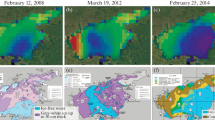Summary
The aim of this study is the evaluation of the sea breeze speed on the basis of its energy. Energetics of the sea breeze can be studied by means of the available potential energy (APE). Part of this energy is transformed into the kinetic energy of the sea breeze. Some similarity exists between the large scale processes of the circulation and the small coastal air circulation due to the fact that both circulations are triggered by the same physics, i.e., solenoidal activity of the baroclinic atmosphere. To evaluate the sea breeze speed, APE was calculated by use of the Lorenz’s equation (1955), and which is possible if the coastal circulation is considered to be a closed system in a hydrostatic equilibrium. For calculations and verifications hourly sea-surface temperatures, near-ground air temperatures and wind speed measurements, as well as the radio-sounding measurements at 12 UTC were used at the Zadar station (ϕ = 44° 08′ N, λ = 15° 13′ E), which is situated in the central part of the eastern Adriatic coast. Two days with an undisturbed sea breeze circulation were extracted using the methods for minimizing other atmospheric influences. Calculated hourly near ground sea breeze speeds obtained in this way were higher than the measured ones. With the assumption that some of the APE is transformed into the kinetic energy it is possible to obtain characteristic speed of the developed sea breeze with small discrepancies to the near-ground measurements. If 6.6% of the mean daily near ground APE was taken to be transformed to the mean daily kinetic sea breeze energy on the 29th and 4.2% on the 30th September 2002, the best agreement was obtained with the mean daily measured near ground sea breeze speed. This range of values can be attributed to inability to extract precise values for the lapse-rate needed in the APE sea breeze calculations. Results show similarities to the general circulation of the atmosphere, since about 10% of the APE is transformed to the kinetic energy of the sea breeze. On the other hand calculated wind speed at the lower branch of the borderline coastal circulation was not dependent on the integral value of the APE over the land, but on its value at the near-ground level.
Similar content being viewed by others
References
D Abbs W Physick (1992) ArticleTitleSea-breeze observations and modelling: A review Aust Meteor Mag 41 7–19
Atkinson BW (1981) Meso-scale atmospheric circulations. Academic Press, 495 pp
S Briere (1987) ArticleTitleEnergetics of daytime sea breeze circulation as determined from a two-dimensional, third-order turbulence closure model J Atmos Sci 44 1455–1474 Occurrence Handle10.1175/1520-0469(1987)044<1455:EODSBC>2.0.CO;2
Britvić S (1990) The height of the internal boundary layer of the coastal area of Northern Adriatic. B Sc Th, Zagreb, University of Zagreb, 68 pp
GA Dalu JSA Green (1980) ArticleTitleEnergetics of diabatic mesoscale circulation: A numerical study Quart J R Met Soc 106 727–734 Occurrence Handle10.1256/smsqj.45005
Y Feliks (1994) ArticleTitleAn analytical model of the diurnal oscillation of the inversion base due to the sea breeze J Atmos Sci 51 991–998 Occurrence Handle10.1175/1520-0469(1994)051<0991:AAMOTD>2.0.CO;2
JSA Green GA Dalu (1980) ArticleTitleMesoscale energy generation in the boundary layer Quart J R Met Soc 106 721–726 Occurrence Handle10.1256/smsqj.45004
B Grisogono L Ström M Tjernström (1998) ArticleTitleSmall scale variability in the coastal atmospheric boundary layer Bound Layer Meteorol 88 23–46 Occurrence Handle10.1023/A:1000933822432
I Herceg (1998) ArticleTitleThe energy cycle in a cyclone over the Bay of Genoa Geofizika 15 15–25
Holton JR (1992) An introduction to dynamic meteorology. Academic Press, 507 pp
Hsu SA (1988) Coastal meteorology. Academic Press, 260 pp
E Lorenz (1955) ArticleTitleAvailable potential energy and the maintenance of the general circulation Tellus VII IssueID2 157–167 Occurrence Handle10.1111/j.2153-3490.1955.tb01148.x
M Margules (1903) ArticleTitleÜber die Energie der Stürme. Jahrb. k.-k. Zentrum für Meteorol Vienna (Translation by C Abbe in Smithson) Misc Coll 51 1910
Marić T (1998) Dynamic climatology of the sea breeze in the region of Šibenik during summer months B Sc Th, Zagreb, University of Zagreb, 44 pp
H Nakane Y Sasano (1986) ArticleTitleStructure of a sea breeze front revealed by a scanning lidar observation J Meteor l Soc Japan 64 787–792
Pielke RA (1984) Mesoscale meteorological modelling. Academic Press, 612 pp
RS Plant BW Atkinson (2002) ArticleTitleSea-breeze modification of the growth of a marine internal boundary layer Bound Layer Meteorol 104 201–228 Occurrence Handle10.1023/A:1016045229957
R Richiardone RA Pearson (1983) ArticleTitleInland convection and energy transfers in a sea breeze model Quart J R Met Soc 109 325–338 Occurrence Handle10.1256/smsqj.46005
R Rotunno (1983) ArticleTitleOn the linear theory of the Land and sea breeze J Atmos Sci 40 1999–2009 Occurrence Handle10.1175/1520-0469(1983)040<1999:OTLTOT>2.0.CO;2
FH Schmidt (1947) ArticleTitleAn elementary theory of the land- and sea-breeze circulation J Meteorol 4 9–15
JE Simpson (1994) Sea breeze and local winds Cambridge University Press Cambridge 234
N Šinik (1986) ArticleTitleOne-dimensional spectral analysis of the available potential energy growth over a limited region Geofizika 3 23–33
DG Steyn (1998) ArticleTitleScaling the vertical structures of sea breezes Bound Layer Meteorol 86 505–524 Occurrence Handle10.1023/A:1000743222389
RB Stull (1988) An introduction to boundary layer meteorology Kluwer Academy Publisher London 665
M Telišman Prtenjak (2003) ArticleTitleMain characteristics of the coastal circulation along eastern coast of Adriatic Geofizika 20 75–92
ABC Tijm AAM Holtslag AJ Van Delden (1999) ArticleTitleObservations and modelling of the sea breeze with the return current Mon Wea Rev 127 625–640 Occurrence Handle10.1175/1520-0493(1999)127<0625:OAMOTS>2.0.CO;2
M Tjernström (1991) ArticleTitleAirborne observations of thermal mesoscale circulations in the coastal marine boundary layer J Geophys Res 96 20499–20520 Occurrence Handle10.1029/91JC02100
M Tjernström A-S Smedman (1993) ArticleTitleThe vertical structure of the coastal marine atmospheric boundary layer J Geophys Res 98 4809–4826
T Trošić (2002) ArticleTitleClimate characteristics of the lower branch of circulation cells along the east coast of Adriatic Sea Croat Met J 37 27–36
Author information
Authors and Affiliations
Rights and permissions
About this article
Cite this article
Trošić, T., Šinik, N. & Trošić, Ž. Available potential energy of the daily coastal circulation at Zadar (Croatia). Meteorol. Atmos. Phys. 93, 211–220 (2006). https://doi.org/10.1007/s00703-005-0179-y
Received:
Revised:
Accepted:
Published:
Issue Date:
DOI: https://doi.org/10.1007/s00703-005-0179-y




